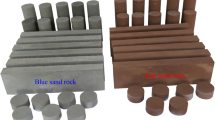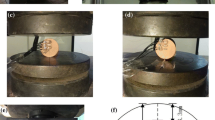Abstract
It is typical for rock material to be bi-modularity in terms of Young’s modulus and Poisson’s ratio. In other words, these values differ in compression (\(E_{{\text{c}}} ,\upsilon_{c}\)) and in tension (\(E_{{\text{t}}} {,}\upsilon_{{\text{t}}}\)). In this work, four kinds of rock materials (sandstone, marble, granite, basalt) were tested to study such bi-modularity behavior in uniaxial compression and in tension (Brazilian disc test). The compressive elastic constants were determined from uniaxial compression testing, while the tensile elastic constants were determined by an improved methodology using displacement measurement in both horizontal and vertical directions of points on the flat surface of a Brazilian disc. Digital image correlation (DIC) was used to monitor the strain and displacement field on the Brazilian disc surface. Validation of the reliability of the testing method is also carried out, and it is found that tensile cracks initiate at the disc center for all tested specimens. Then, the rationality of the determined tensile elastic constants is validated by comparison with the values obtained from the direct tensile tests. Finally, based on the experimental data, it is found that the values of \({{E_{{\text{t}}} } \mathord{\left/ {\vphantom {{E_{{\text{t}}} } {E_{{\text{c}}} }}} \right. \kern-\nulldelimiterspace} {E_{{\text{c}}} }}\) and \({{\upsilon_{{\text{t}}} } \mathord{\left/ {\vphantom {{\upsilon_{{\text{t}}} } {\upsilon_{{\text{c}}} }}} \right. \kern-\nulldelimiterspace} {\upsilon_{{\text{c}}} }}\) of each rock type are similar, except for marble. As the ratio of tensile to compressive strength increases, the value of \({{E_{{\text{t}}} } \mathord{\left/ {\vphantom {{E_{{\text{t}}} } {E_{{\text{c}}} }}} \right. \kern-\nulldelimiterspace} {E_{{\text{c}}} }}\) also appears to increase slightly. Lastly, the mechanism of bi-modular behavior of rock is discussed.














Similar content being viewed by others
Abbreviations
- \(x\) :
-
X-Coordinate of a point on the horizontal diameter AB of the Brazilian disc
- \(y\) :
-
Y-Coordinate of a point on the vertical diameter EF of the Brazilian disc
- \(P\) :
-
Applied load in y-direction
- \(D\) :
-
Disk diameter
- \(t\) :
-
Thickness of the Brazilian disc
- \(\sigma_{{\text{c}}}\) :
-
Uniaxial compression strength
- \(\sigma_{{\text{t}}}\) :
-
Brazilian tensile strength
- \(\overline{{\sigma_{{\text{t}}} }}\) :
-
Direct tensile stress
- \(\sigma_{xx}\) :
-
Stress in x-direction
- \(\sigma_{yy}\) :
-
Stress in y-direction
- \(\varepsilon_{xx}\) :
-
Strain in x-direction
- \(\varepsilon_{yy}\) :
-
Strain in y-direction
- \(\varepsilon_{{\text{t}}}\) :
-
Direct tensile strain
- \(\varepsilon_{{{\text{t0}}}}\) :
-
Tensile strain at the center of the Brazilian disc
- \(\upsilon_{{\text{c}}}\) :
-
Poisson’s ratio in compression
- \(\upsilon_{{\text{t}}}\) :
-
Poisson’s ratio in tension
- \(E_{{\text{c}}}\) :
-
Young’s modulus in compression
- \(E_{{\text{t}}}\) :
-
Young’s modulus in tension
- \(u\) :
-
Displacement in x-direction
- \(v\) :
-
Displacement in y-direction
- \(M_{u}\) :
-
Slope of linear fit for u versus P plot
- \(M_{v}\) :
-
Slope of linear fit for v versus P plot
- OB:
-
Horizontal axis of reference
- OE:
-
Vertical axis of reference
References
Akazawa T (1943) New test method for evaluating internal stress due to compression of concrete: the splitting tension test. J Japan Soc Civil Eng 29:777–787
Aliabadian Z, Zhao GF, Russell AR (2019) Crack development in transversely isotropic sandstone discs subjected to Brazilian tests observed using digital image correlation. Int J Rock Mech Min Sci 119:211–221
Ambartsumyan SA (1969) Basic equations and relations in the theory of elasticity of anisotropic bodies with difering moduli in tension and compression. Inzh Zh Meth Tverd Tela 3:51–61
ASTM Standard D3967-08 (2008) Standard test method for splitting tensile strength of intact rock core specimens. In: ASTM International, West Conshohocken, pp 20–23
Belrhiti Y et al (2017) Combination of Brazilian test and digital image correlation for mechanical characterization of refractory materials. J Eur Ceram Soc 37(5):2285–2293
Carneiro FLLB (1943) A new method to determine the tensile strength of concrete. In: Paper presented at the Proceedings of the 5th meeting of the Brazilian Association for Technical Rules (‘‘Associacao Brasileire de Normas Tecnicas—ABNT’’), 3d.section
Chen S, Yue ZQ, Tham LG (2004) Digital image-based numerical modeling method for prediction of inhomogeneous rock failure. Int J Rock Mech Min 41(6):939–957
Chu T, Ranson W, Sutton M (1985) Applications of digital-image-correlation techniques to experimental mechanics. Exp Mech 25:232–244
Corelated Solutions (2010a) CSI Application Note AN-824. Columbia, SC, USA. www.CorrelatedSolutions.com
Corelated Solutions (2010b) Vic-3D 2010 Reference Manual. Columbia, SC, USA. www.CorrelatedSolutions.com
Gong FQ, Li XB, Zhao J (2010) Analytical algorithm to estimate tensile modulus in Brazilian disk splitting tests. Chin J Rock Mech Eng 29(5):881–891 ((in Chinese))
Haimson BC, Tharp TM (1974) Stresses around boreholes in bilinear elastic rock. Soc Petrol Eng J 14(2):145–151
Han ZY, Li DY, Zhou T, Zhu QQ, Ranjith PG (2020) Experimental study of stress wave propagation and energy characteristics across rock specimens containing cemented mortar joint with various thicknesses. Int J Rock Mech Min Sci 131:104–352. https://doi.org/10.1016/j.ijrmms.2020.104352
Hondros G (1959) The evaluation of Poisson’s ratio and the modulus of materials of a low tensile resistance by the Brazilian (indirect tensile) test with particular reference to concrete. Aust J Appl Sci 10(3):243–268
ISRM (1978) Suggested methods for determining tensile strength of rock materials. Int J Rock Mech Min Sci Geomech Abstr 15:99–103
Fuenkajorn K, Klanphumeesri S (2011) Laboratory determination of direct tensile strength and deformability of intact rocks. Geotech Test J 34(1):1–6
Kourkoulis SK, Markides ChF, Chatzistergos PE (2012) The Brazilian disc under parabolically varying load: theoretical and experimental study of the displacement field. Int J Solids Struct 49:959–972
Lavrov A, Vervoort A (2002) Theoretical treatment of tangential loading effects on the Brazilian test stress distribution. Int J Rock Mech Min 39(2):275–283
Li DY, Wong L (2013) The Brazilian disc test for rock mechanics applications: review and new insights. Rock Mech Rock Eng 46:269–287
Li DY, Zhu QQ, Zhou ZL, Li XB, Ranjith PG (2017) Fracture analysis of marble specimens with a hole under uniaxial compression by digital image correlation. Eng Fract Mech 183:109–124
Li DY, Han ZY, Zhu QQ, Zhang Y, Ranjith PG (2019a) Stress wave propagation and dynamic behavior of red sandstone with single bonded planar joint at various angles. Int J Rock Mech Min Sci 117:162–170
Li DY, Han ZY, Sun XL, Zhou T, Li XB (2019b) Dynamic mechanical properties and fracturing behavior of marble specimens containing single and double flaws in SHPB tests. Rock Mech Rock Eng 52(6):1623–1643
Liu C (2010) Elastic constants determination and deformation observation using Brazilian disk geometry. Exp Mech 50(7):1025–1039
Markides ChF, Pazis DN, Kourkoulis SK (2010) Closed full-field solutions for stresses and displacements in the Brazilian disk under distributed radial load. Int J Rock Mech Min Sci 47:227–237
Martin CD, Patel S (2018) Application of digital image correlation technique for measurement of tensile elastic constants in Brazilian tests on a bi-modular crystalline rock. Geotech Test J 41(4):664–674
Patel S, Martin CD (2018) Evaluation of tensile young’s modulus and poisson’s ratio of a bi-modular rock from the displacement measurements in a Brazilian test. Rock Mech Rock Eng 51:361
Sharafisafa M, Shen LM, Xu QF (2018) Characterisation of mechanical behaviour of 3D printed rock-like material with digital image correlation. Int J Rock Mech Min Sci 112:122–138
Sundaram PN, Corrales JM (1980) Brazilian tensile strength of rocks with diferent elastic properties in tension and compression. Int J Rock Mech Min Sci Geomech Abstr 17(2):131–133
Wang QZ, Wang XM, Jia SQ (2004) The flattened Brazilian disc specimen used for testing elastic modulus, tensile strength and fracture toughness of brittle rocks: analytical and numerical results. Int J Rock Mech Min Sci 41:245–253
Wawersik WR (1968) Detailed analysis of rock failure in laboratory compression tests. In: PhD Thesis, University of Minnesota, Minneapolis, USA
Yanagidani T, Sano O, Terada M, Ito I (1978) The observation of cracks propagating in diametrically-compressed rock discs. Int J Rock Mech Min 15(5):225–235
Yang SQ, Yin PF, Huang YH (2019) Experiment and discrete element modelling on strength, deformation and failure behaviour of shale under Brazilian compression. Rock Mech Rock Eng 52(7):4339–4359
Ye JH, Wu FQ, Sun JZ (2009) Estimation of the tensile elastic modulus using Brazilian disc by applying diametrically opposed concentrated loads. Int J Rock Mech Min Sci 46(3):568–576
Ye JH, Wu FQ, Zhang Y, Ji HG (2012) Estimation of the bi-modulus of materials through deformation measurement in a Brazilian disk test. Int J Rock Mech Min Sci 52:122–131
Yu Y (2005) Questioning the validity of the Brazilian test for determining tensile strength of rocks. Chin J Rock Mech Eng 24:1150–1157
Yu Y, Wang TX (2004) Study on relationship between splitting behavior and elastic modulus of three Gorges granite. Chin J Rock Mech Eng 23:3258–3261 ([in Chinese])
Yu JH, Shang XC, Wu PF (2019) Influence of pressure distribution and friction on determining mechanical properties in the Brazilian test: theory and experiment. Int J Solids Struct 161:11–22
Zhang ZQ, Guan BS, Zheng DF (1998) Determination of elastic modulus of rocks with cracked straight through Brazilian disc specimen by compliance method. Chin J Rock Mech Eng 17:372–378
Zhu QQ, Li DY, Han ZY, Li XB, Zhou ZL (2019) Mechanical properties and fracture evolution of sandstone specimens containing different inclusions under uniaxial compression. Int J Rock Mech Min Sci 115:33–47
Acknowledgements
The authors would like to acknowledge the financial support from the National Natural Science Foundation of China (no. 52074349) and the Outstanding Youth Science Foundations of Hunan Province of China (no. 2019JJ20028), and the Graduate Student Research and Innovation Fund of Central South University (no. 1053320191340).
Author information
Authors and Affiliations
Corresponding author
Ethics declarations
Conflict of interest
The authors declare that they have no conflict of interest.
Additional information
Publisher's Note
Springer Nature remains neutral with regard to jurisdictional claims in published maps and institutional affiliations.
Rights and permissions
About this article
Cite this article
Li, D., Li, B., Han, Z. et al. Evaluation of Bi-modular Behavior of Rocks Subjected to Uniaxial Compression and Brazilian Tensile Testing. Rock Mech Rock Eng 54, 3961–3975 (2021). https://doi.org/10.1007/s00603-021-02469-0
Received:
Accepted:
Published:
Issue Date:
DOI: https://doi.org/10.1007/s00603-021-02469-0




